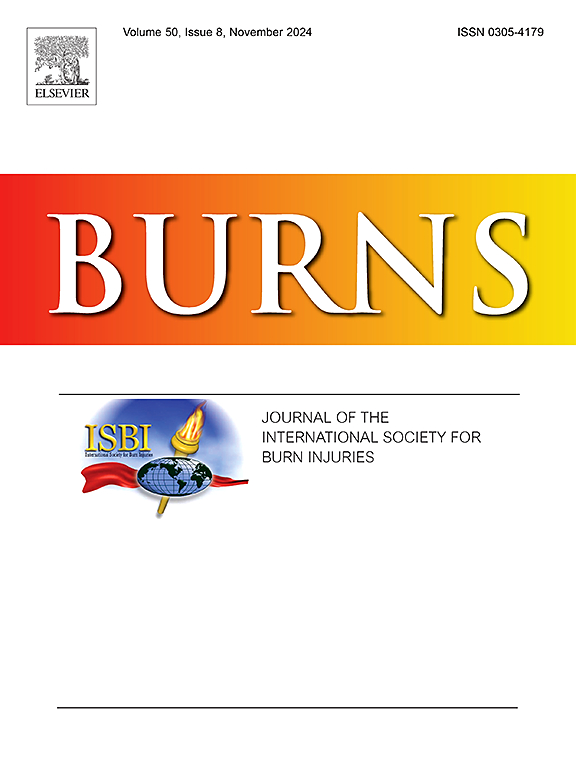全年成人严重烧伤的模式
IF 2.9
3区 医学
Q2 CRITICAL CARE MEDICINE
引用次数: 0
摘要
了解一年中不同时间和全天的烧伤模式对于制定有针对性的预防策略和改善患者预后至关重要。季节变化通常与环境条件、活动和行为有关,对烧伤的发生频率和严重程度起着关键作用。通过识别这些模式,我们可以更好地为公共卫生倡议提供信息,并优化医疗机构中烧伤治疗的资源分配。材料和方法本研究采用回顾性队列研究,分析了德国烧伤协会2016年至2023年的烧伤登记数据。在分析期间,10432名成人患者纳入本研究。结果:无论是工作日还是周末,下午2点到3点之间的入场人数最多 。患者在周六烧伤最多(n = 1578;15.1 %),周二烧伤发生率最低( = 1390;13.3 %)。火焰伤害、油脂伤害和爆炸伤害的分布在夏季明显增加,秋季和冬季较少。烧伤患者数量的高峰出现在1月1日,有83例(0.8 %)报告病例需要在重症监护病房治疗。需要在重症监护病房治疗的烧伤最少的一天是12月1日,有11例(0.1% %)。结论多种外部因素影响烧伤的发生频率。午后早期和夏季入场频率呈现明显的高峰。一周的天数只显示出很小的变化。本文章由计算机程序翻译,如有差异,请以英文原文为准。
Patterns of severe burn injury in adults throughout the year
Introduction
Understanding the patterns of burn injuries over different times of the year and throughout the day is crucial for developing targeted prevention strategies and improving patient outcomes. Seasonal variations, often linked to environmental conditions, activities, and behaviors, play a critical role in the frequency and severity of burn injuries.
By identifying these patterns, we can better inform public health initiatives and optimize resource allocation in healthcare settings for the treatment of burn injuries.
Material and methods
The study was conducted as a retrospective cohort study by analyzing the data from the burn registry of the German Burn Society from 2016 to 2023.
In the analyzed period, 10432 adult patients were included in the present study.
Results
Regardless of the day of the week or the weekend, a peak in admissions can be seen between 2 and 3 pm. Patients suffered the most burn injuries on a Saturday (n = 1578; 15.1 %), while the fewest burn injuries occurred on a Tuesday (n = 1390; 13.3 %).
The distribution of flame, grease/oil, and explosion injuries shows a clear increase in the summer and a lower number of cases in autumn and winter.
A peak in the number of patients with burn injury is seen on the 1st of January, with 83 (0.8 %) reported cases requiring treatment in an intensive care unit. The day with the fewest burn injuries requiring treatment in an intensive care unit is 1 December with 11 cases (0.1 %).
Conclusion
In summary, various external factors influence the frequency of burn trauma. The early afternoon and the summer season show clear peaks admission frequency. The days of week only showed a minor variation.
求助全文
通过发布文献求助,成功后即可免费获取论文全文。
去求助
来源期刊

Burns
医学-皮肤病学
CiteScore
4.50
自引率
18.50%
发文量
304
审稿时长
72 days
期刊介绍:
Burns aims to foster the exchange of information among all engaged in preventing and treating the effects of burns. The journal focuses on clinical, scientific and social aspects of these injuries and covers the prevention of the injury, the epidemiology of such injuries and all aspects of treatment including development of new techniques and technologies and verification of existing ones. Regular features include clinical and scientific papers, state of the art reviews and descriptions of burn-care in practice.
Topics covered by Burns include: the effects of smoke on man and animals, their tissues and cells; the responses to and treatment of patients and animals with chemical injuries to the skin; the biological and clinical effects of cold injuries; surgical techniques which are, or may be relevant to the treatment of burned patients during the acute or reconstructive phase following injury; well controlled laboratory studies of the effectiveness of anti-microbial agents on infection and new materials on scarring and healing; inflammatory responses to injury, effectiveness of related agents and other compounds used to modify the physiological and cellular responses to the injury; experimental studies of burns and the outcome of burn wound healing; regenerative medicine concerning the skin.
 求助内容:
求助内容: 应助结果提醒方式:
应助结果提醒方式:


